Cooking your first Thanksgiving turkey this year? Here's how
Don’t be intimidated by the bird.
 Credit:
Reviewed / Valerie Li Stack
Credit:
Reviewed / Valerie Li Stack
Recommendations are independently chosen by Reviewed's editors. Purchases made through the links below may earn us and our publishing partners a commission. Prices were accurate at the time this article was published but may change over time.
If you’re hosting Thanksgiving for the first time, learning how to roast a turkey may be one of many new endeavors. From sourcing your bird to serving up beautifully carved pieces, this process definitely requires a bit of time and energy, but achieving turkey perfection is easier than you might think. My uncle-in-law has been in charge of cooking our turkey for the last several years. For this guide, he generously shared his recipe and advice—and since not everyone is as experienced as he is (myself included), I decided to go the whole nine yards when cooking a turkey as a first-timer.
First, pick a turkey that’s the right size for your cooking vessel
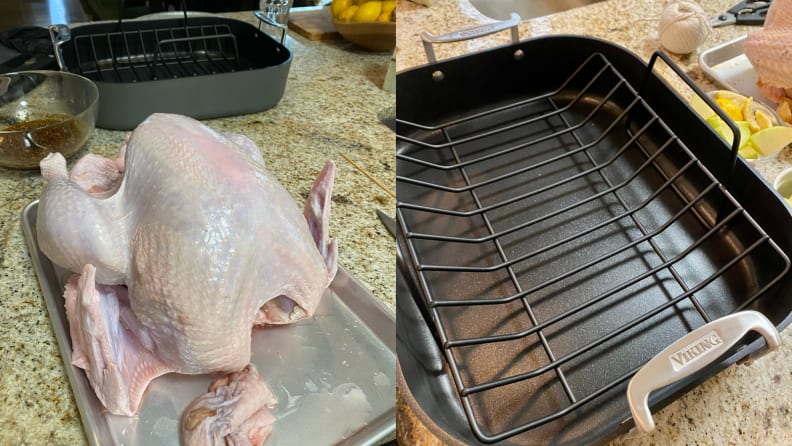
We used a 16-by-13 roasting pan for our 13-pound turkey.
To select the right size bird, you’ll generally need one pound of turkey per person. If you’re celebrating Thanksgiving on a smaller-than-usual scale, then your best bet is likely a smaller bird. (Turkeys can range anywhere from 8 to 22 pounds or more.)
Once you pick your turkey, make sure your oven and roasting pan are both big enough for the bird. If you're in the market for a roasting pan, check out the best we've tested, the Viking 3-Ply Stainless Steel Roasting Pan with Nonstick Rack. And if your turkey is too big for your oven, consider moving the whole operation outdoors and smoking your turkey instead.
Choose the method you’re most comfortable with
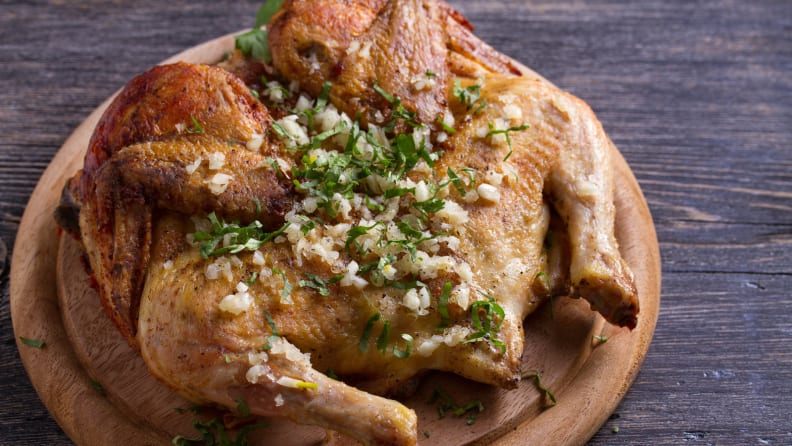
If you're an experienced cook, you may want to try the spatchcock method this year.
In this guide, you’ll find instructions for a simple roasted turkey. If you’re a culinary enthusiast and looking to up your turkey game, we recommend the spatchcock method. Keep in mind that spatchcocking may require a strong pair of poultry shears—like the best we tested, the OXO Good Grips Spring-Loaded Poultry Shears—to remove the backbone of the bird.
If you’re looking to stuff your bird, grab a ball of baker's twine to tie up the turkey so everything remains intact through several hours in a hot oven.
Make sure you have all the tools you need
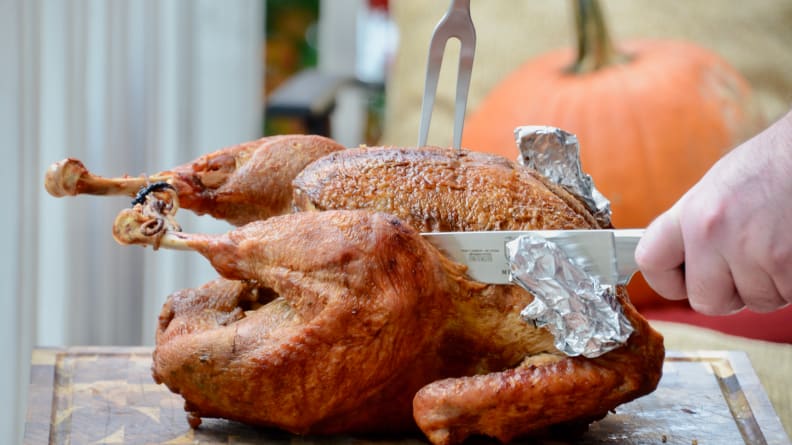
Don't forget to get a decent set of carving knife and fork.
When it comes to cooking a large bird in a small-ish kitchen, there are a few little tools that may go a long way. Make a checklist of items such as a carving knife set, a durable roasting pan, baster, and any other items you’re missing that we’ve mentioned in our Thanksgiving tools guide. Don’t forget to add a meat thermometer to that list—it’s a lifesaver for a first time Thanksgiving turkey cook.
Schedule your cooking day timeline
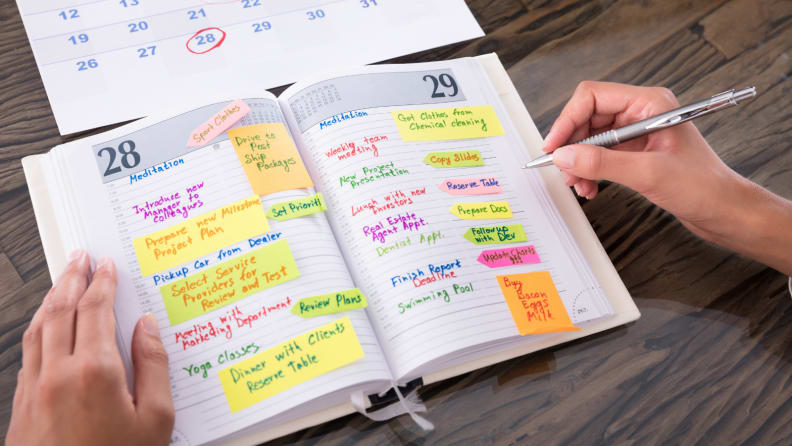
Making a to-do list ahead of time will help reduce the stress of cooking.
Similar to baking a loaf of sourdough bread, you’ll need a schedule—a detailed plan to get yourself mentally prepared for each step of cooking, reducing the likelihood of having guests waiting around with empty stomachs.
You can calculate the approximate cooking time for your bird based on weight—for every pound of meat, you’ll need about 20 minutes of roasting time. To check doneness once your bird has been cooking for a while, stick a meat thermometer into the thickest part. The turkey is done when its internal temperature reaches 165°F.
Once you’ve got all these bases covered, you’re ready to roast!
How to cook a turkey as a beginner cook
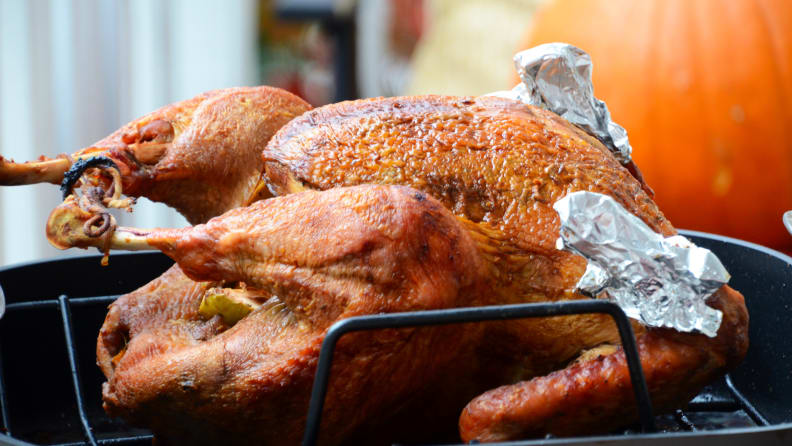
Cooking a whole turkey isn't as challenging as you may think.
Ingredients
- Turkey
- Marinade or a dry rub of your choice
- 1 stick of butter, melted
- 2 tablespoons honey
- 1 teaspoon dark soy sauce
- 1 apple, chopped into pieces (I cook my stuffing separately, but if you like to cook the stuffing inside the bird, you can swap out the apple here)
Tools
- A roll of paper towels
- A toothpick
- A pastry brush
- A sheet pan
- A roasting pan with rack (we used the Viking 3-Ply Stainless Steel Roasting Pan with Nonstick Rack)
- 2 small mixing bowls (one for the marinade and one for the honey with dark soy sauce mixture)
- A carving knife set with poultry shears (we used the Mercer Culinary Genesis 4-piece Carving Knife Set)
- A turkey baster
- A meat thermometer or probe thermometer
- A cutting board
- Optional: A pair of food-safe gloves
Step-by-Step:
Step 1: Thaw the turkey
Move the frozen turkey out of the freezer and let thaw in the refrigerator for 48 hours. Or, you can submerge the turkey in cold water in a large sink for several hours (you’ll need to submerge for 30 minutes per pound of turkey). One important tip is make sure your turkey isn’t blocking the drain because I almost flooded my house when doing this!
Step 2: Prep the turkey
Pat the turkey dry. Gently poke the skin multiple times with a toothpick to let the air escape while cooking. Use poultry shears to trim the fat, then discard fat.
Brush the whole bird with marinade and let sit for at least two hours before cooking. To help the marinade sink in faster, you can slip the marinade under the turkey skin (near the breast) and distribute the marinade evenly by massaging with your hands.
Step 3: Into the oven
Heat the oven to 450°F. Pat the whole bird super dry (very important) and transfer the bird to the roasting pan. If your roasting pan has a rack, then position the turkey with the breast side facing up on the rack and make sure it’s in a stable position. Lift up and transfer the pan into the oven. Let bake for 20 minutes and remove from the oven.
Step 4: Basting
Lower the temperature to 325°F. Flip the bird with the breast side down and baste the bird with melted butter. Make sure the melted butter covers every corner of the bird. Baste the turkey every 20 minutes until the internal temperature reaches 165°F. (You may also use drippings in pan to baste in addition to the melted butter.)
Step 5: The finishing touch
To give the bird a golden brown and crispy exterior, I borrowed this technique from Peking duck recipes—brush the skin with a mixture of honey and dark soy sauce. Both ingredients are used extensively in Chinese cooking to achieve a darkened, vibrant color. Save this for the last 15 minutes of roasting because honey has a low smoke point—to avoid burning, you must keep an eye on it.
Step 6: Let the bird rest
Now that the turkey has gone through hours of intense cooking, it’s time for a little nap. Remove the turkey from the roasting pan and let the bird rest on a cutting board for an hour before carving. Save the liquid in the roasting pan to make gravy.
These are the most basic steps to follow if you plan to cook a whole bird this year. If you are an experienced home cook and want to prepare your turkey differently, check out the 10 alternative ways to cook a Thanksgiving turkey that we put together.





